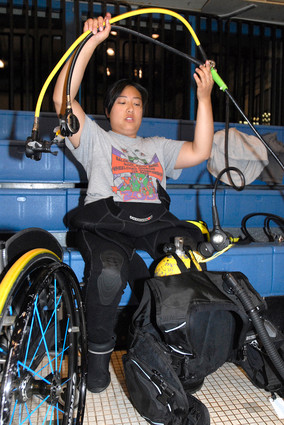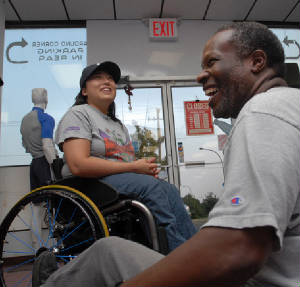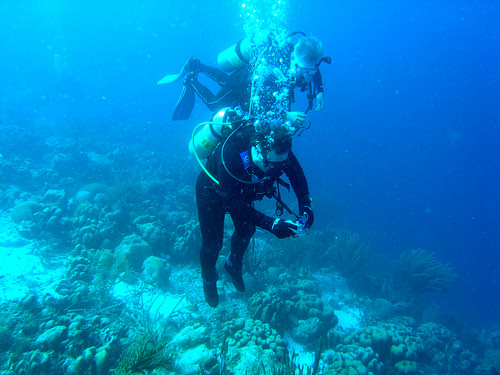|

BY BILL BLEYER
11:50 AM EDT, September 12, 2008
Jennifer Choi bobbed to the
surface of a Pennsylvania lake, dropped the scuba regulator from her mouth and addressed instructor Martha Katz.
"I'm
done?" she asked expectantly.
"You're done," Katz responded with a big smile.
What Choi, a 26-year-old New York
University doctoral student from Westbury, had done at the Dutch Springs quarry was complete her 13th dive and her advanced
open-water scuba diving certification.
Thousands of people every year do that. What made Choi's accomplishment more
unusual is that she is paraplegic. Born with spina bifida, she has been unable to walk since age 9. But she didn't let that
stop her from learning to dive.
Katz, a Glen Cove resident who owns the Scuba Network shop in Carle Place, was able
to help Choi accomplish her goal because she and three of her instructors have received training and certification from the
Handicapped Scuba Association. They have trained more than a dozen disabled divers in the past five years.
Katz added
the specialty because "I love teaching, and I love teaching disabled people. It gives me a very good feeling to see people
enjoying the water and see them smile from ear to ear and accomplish something different." She hopes eventually to include
disabled veterans coming back from Iraq as students.
To be certified as an instructor by the 27-year-old California-based
Handicapped Scuba Association, Katz said, regular instructors must take the association's course, which already has been completed
by 2,000 people in 45 countries.
"They teach you not only to teach people who are paralyzed from the waist down but
also totally paralyzed from the head down, blind people, people with any kind of disability, deaf, blind," she said. Those
paralyzed from the head down are towed by instructors. "You have to practice with different people until you are able to control
everybody."
Learning how to dive can be complicated even without a disability. With the handicapped, Katz said, "it
takes a lot of time, a lot of patience. You have to do things slower. Some of the handicapped are very independent and don't
want any help, and you have to be very close to them to make sure that they can achieve buoyancy and are not going to drop
to the bottom."
Katz said divers like Choi who cannot use their legs need different weight configurations. "Because
their legs have no movement, they tend to float up, so we give them ankle weights," she said. Paraplegic divers wear special
webbed gloves that serve as paddles rather than wearing fins on their feet.
After becoming comfortable in the water,
a disabled diver is usually accompanied by one or two instructors. But some of the divers can function on their own once they
are in the water.

Choi is Katz's star pupil, having gone on to complete her dive-master certification,
a step in her plan to become an instructor herself. "It's definitely something that's on my to-do list," Choi said.
"I
tend to be one of those people that once I start something, I want to get really, really good at it," said Choi, a Stony Brook
University graduate studying neuroscience and physiology with the goal of becoming a college professor.
After she could
no longer walk, Choi said, "I had a list starting in middle school of all the extreme sports I wanted to do with my friends,
and scuba diving happened to be on that list. I've always been an adrenaline-addict kind of person."
The first sport
on her list was downhill skiing, and she began that in college. Scuba diving was number two, and she began that two years
ago. "I decided to pick it up when one of my closest friends decided to get married in Belize, so I decided I might as well
pick up scuba diving." She wanted to dive on the coral reefs there. She said she wasn't nervous about trying diving "because
I was really into swimming. I did a little bit of competitive swimming in high school. The first day, I realized this is one
thing I'm going to enjoy."
Choi said she had always been fascinated by aquatic creatures, but the main attraction for
diving was "not being burdened by gravity."
"It's the weightlessness," she said. "It's unique."

After her initial open-water certification, Choi began the advanced open-water
class that brought her to the flooded Dutch Springs quarry. Choi donned her wet suit, and then Scuba Network instructor Larry
Mack rolled her wheelchair down a path to the water's edge, lifted her and lowered her into the water and then checked her
buoyancy.
Then, Katz and Choi dove to 60 feet to a downed helicopter for her required deep dive. Choi was required
to write on a slate what the water depth was, how much air she had used and how long she had been in the water. She repeated
the assignment at 50 feet before Katz led her into the helicopter to see if Choi could maintain her buoyancy.
"She
did very good," Katz said afterward. "She was completely neutrally buoyant, and she was very comfortable in her swimming.
She was able to go in and out of the wreck without touching the top or the bottom."
They ascended slowly to 20 feet
to avoid decompression sickness, also known as the bends, and swam to a World War II fighter plane. Katz had Choi check her
compass for the navigation requirement. This was followed by Katz and Choi doing an underwater chicken dance signifying the
completion of the advanced open-water training before surfacing.
Choi spent the next three months becoming certified
as a dive master, completing another seven dives and classroom training. The next step toward becoming an instructor would
be a rescue-diver class. Rescuing another diver in trouble would mean swimming with only one hand while using the other to
hold the second diver. "I think that will be the biggest challenge," Choi said.
But Katz said, "I'm sure she will be
able to manage it because of the drive she has." Choi would then have to learn CPR and first aid and pass the training assistant,
assistant instructor and finally the instructor courses. "I think she will be a very good instructor," Katz said.

"It's the freedom"
While Choi knew she
wanted to learn how to dive, another of Katz's students, Roger Tribelhorn of Bayville, backed into it two years ago.
A
53-year-old manager for an Oyster Bay electronic components firm, Tribelhorn ended up in a wheelchair after he was diagnosed
with transverse myelitis eight years ago. The neurological disorder cost him the use of his legs.
His son and daughter
wanted to learn how to dive because they were planning a trip to Australia. His daughter, Patricia, made a list of local dive
shops and asked her dad to check them out with her.
When they got to Katz's store, "Martha explained everything, and
she told me, 'You can do it, too,' " Tribelhorn said. "That's all I needed to know, because I always was very active - skiing,
swimming - so I needed something."
Tribelhorn constructed his own PVC-pipe wheelchair with large wheels so he could
get down to Long Island Sound to dive near his home. And last winter, he and his kids traveled to Bonaire, off the northern
coast of South America, for his first diving trip, a weeklong vacation with Katz.

"It was very, very nice," he said, "but; I told Martha
I want to be able to dive with my kids" without an instructor. "I wanted to prove to myself that I could do it. I always was
independent." With the webbed gloves, he said, "I can keep up with anybody."
So during his 14 dives on the trip, he
completed the HSA course for independent diving as well as the advanced open-water course from the National Association of
Underwater Instructors. Now, he's planning a trip to Cozumel, Mexico, and hopes to do more wreck diving after visiting one
hulk in Bonaire. "I'd really like to see caves," he added.
"Because I'm a tool and die maker by trade, I like to see
how things work," Tribelhorn said. So he wants to become certified for maintaining scuba regulators so he can work part-time
in Katz's shop.
"It's beautiful down there," Tribelhorn said of one attraction of diving. But there is a bigger benefit.
"It's the freedom. Being neutrally buoyant is the most awesome feeling that I've ever experienced. Everything is so relaxed
down there."
Tribelhorn said that when he dives, he no longer feels disabled. "The chair is not an issue anymore. You
don't think about it. I can go up. I can go down. There is no limitation."

|
